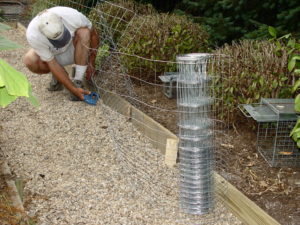10 Ways to Get the Most Out of Your Vegetable Garden
If you’re investing the work into growing your own food garden – as so many stuck-at-home people did for the first time last spring – you may as well get the most out of it.
As you plant cool-season crops now (onions, broccoli, cabbage, etc.) and summer crops in May (tomatoes, peppers, cucumbers, etc.), here are 10 ways to maximize your yield and effort:
1.) Raised beds. Hardly anyone has good soil, so don’t expect great results by just stripping off grass and planting.
Loosen the soil at least six inches deep. Eight to 12 inches is even better. Then dig or till in two to three inches of compost, peat moss, rotted leaves, mushroom soil, or similar organic matter so the beds end up “fluffy” and a few inches above grade.
Most people build boxes to contain the soil (stone, blocks, brick, recycled plastic timbers, or rot-resistant boards), but you can just mound up the beds without any edging.
The loose, raised beds give you good drainage and allow veggie roots to spread with impunity. Four-foot bed widths are ideal.
2.) Test the soil. Once you’ve addressed the soil quality, run a soil test to see if you need to adjust the acidity level (indicated by its pH reading) or add any fertilizer.
The cheapest, easiest way is to buy a do-it-yourself, mail-in Penn State soil test kit. These are available for $9-$10 at county Extension offices, most garden centers, or online at Penn State’s soil-testing lab.
The test report will tell you what to add (if anything) and in what amounts.
3.) Go with the best “paybackers.” These are the crops that yield the most for the space and effort you devote to them.
Ones that give some of the best bang for the buck are tomatoes, peppers, carrots, cucumbers, asparagus, the onion family (including leeks, shallots and garlic), lettuce, squash, rhubarb, beans, and snow peas.
4.) Best varieties. Some particular varieties of each crop yield better, taste better, or fight off bugs and disease better than others.
It pays to invest in the best performers to give yourself a genetic advantage right off the bat. Cheapie seeds are usually inferior.
Research varieties, compare notes with friends, or experiment until you find the ones that do best in your garden.
Or read the post I wrote here earlier this year on “My All-Time Favorite Vegetable Varieties.”
5.) Start early, finish late. Planting the vegetable garden isn’t just a May thing. You can milk out weeks and even months of extra production by planting cool-season crops (peas, onions, lettuce, etc.) as early as March and by replanting a fall cool-season crop.
Read George’s PennLive post on when to plant which vegetables
Plant protectors such as floating row covers, clear plastic domes, and even milk jugs can help on those really cold nights.
A highly productive vegetable garden has no empty space during the growing season. Plant continuously. As one crop is harvested, fill the space with something seasonally appropriate.
6.) Plant closely. That loose, rich, raised-bed soil will let you space plants closer than the packs say.
More importantly, plant in blocks instead of rows. Raised beds don’t waste space because you’re cutting down on row space by working only from the perimeter – never in the beds themselves.
A good spacing guide is Mel Bartholomew’s Square Foot Gardening system and book. See www.squarefootgardening.com or “The All New Square Foot Gardening” (Cool Springs Press, 2006, $19.99).
7.) Use vertical space. Grow vining and climbing plants up a trellis, cage, or similar support.
You’ll get way more cucumbers and melons this way instead of letting them sprawl along the ground.
Pole beans, pole peas, pumpkins, gourds, and malabar spinach are other vertical options.
8.) Water consistently. Water is the magic gardening ingredient. Keep the soil consistently damp (but never soggy) to keep those roots growing and the plants producing at maximum level.
Your finger is a good gauge to determine if the soil is damp at the root level.
9.) Control weeds. Weeds compete for nutrients and moisture in the garden. Yank them as soon as any emerge, and never let a weed go to seed to create next year’s trouble.
Better yet, put down a light layer of chopped leaves or straw between the plants to discourage weeds as well as conserve moisture.
10.) Be ready for animals. Assorted animals (especially deer, rabbits, groundhogs and voles) love your vegetables as much as you do. Deer and groundhogs especially can decimate an entire garden in just one night.
Figure on fencing the garden right off the bat. Sink a six-inch board the whole way around the perimeter to discourage burrowing, then erect a three-foot, narrow-opening fence that’s left unsecured at the top (so groundhogs lack support to climb over).
Whole books have been written on keeping animals out of the garden with options including repellents, electric fencing, traps, scare devices, ill-tempered pets and more.
Read my past post on “How to Keep Animals from Eating Your Harvest.”











